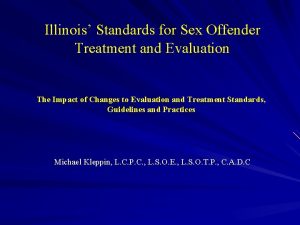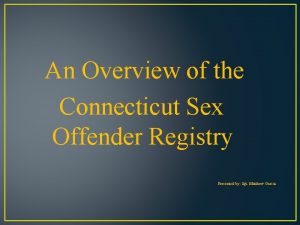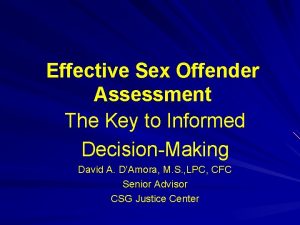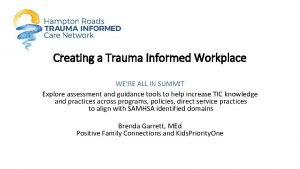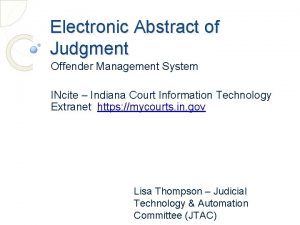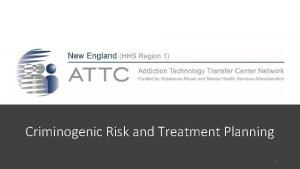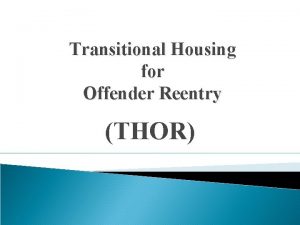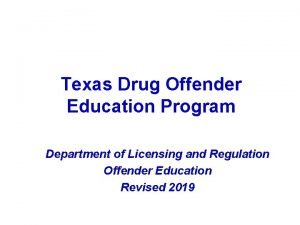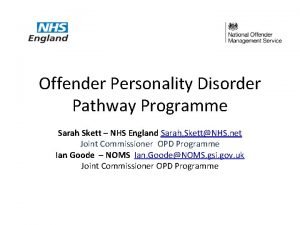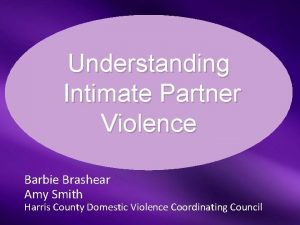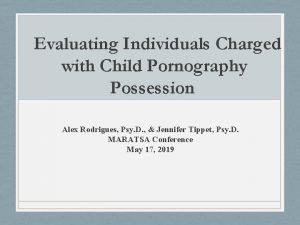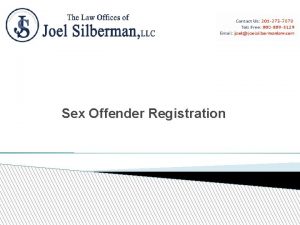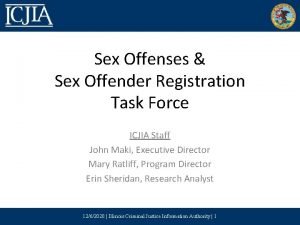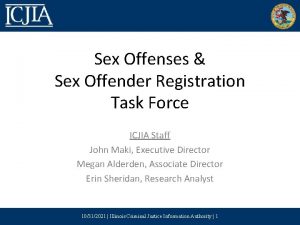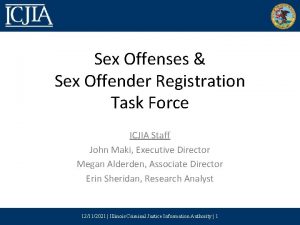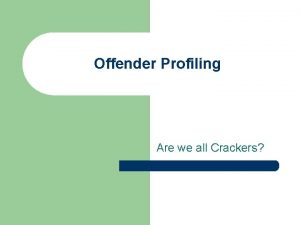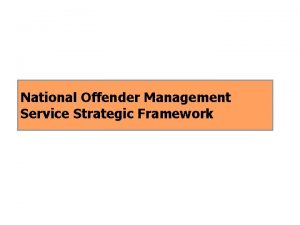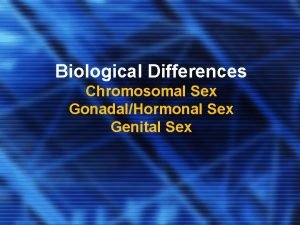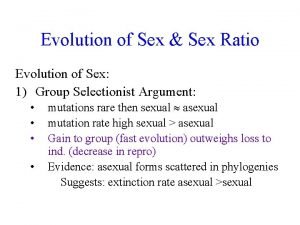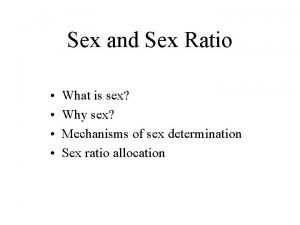Effective Sex Offender Assessment The Key to Informed





























- Slides: 29

Effective Sex Offender Assessment The Key to Informed Decision-Making David A. D’Amora, M. S. , LPC, CFC Senior Advisor CSG Justice Center

Assessment Defined To estimate or determine the significance or importance of something; or To evaluate; or To observe or monitor

Why Assess? Key decision points with sex offenders require careful consideration, and many myths have developed in the public, among treatment providers, judicial actors, and supervisors

Key Decision Points: Implications for Assessment Sentencing/ Disposition Institutional/ Residential Placement Transition and Reentry Community

Why Assess? • Adults who commit sex offenses are a diverse • • • and heterogeneous population. Some are very dangerous, some are not. Some are deviant, some are not. Some require long-term treatment, some shortterm, some other, and some none, Some require specialized supervision, and some do not Some require intense supervision, and some do not.

Why Assess? To explore critical variables on a case-by-case basis and develop management strategies accordingly – One size does not fit all! – Interventions should be tailored to meet individual levels of risk and criminogenic needs

Why Assess? To inform clinical decisions – Institutional treatment – Community-based aftercare Treatment planning – Treatment progress, completion, discharge – Family reunification

Assessment Is The Key To Informed Decision-making

What Should Be Assessed? Protective and risk factors – Criminogenic needs – Non-criminogenic needs Risk for recidivism – Sexual – Non-sexual Victim impact and safety issues

Overarching Considerations Core Principles of Effective Correctional Intervention – Risk – Needs – Responsivity (see, e. g. , Andrews, 1994, Andrews & Bonta, 1998, 2003; Cullen & Gendreau, 2000; Gendreau, 1996)

Risk Principle: “Who” Should Receive the Most Services? Identify the offender’s risk level. Match the level of services to this risk level.

Need Principle: “What” Problems Should be Targeted in the Initial Response? Identify those changeable risk factors that are directly linked to the offender’s offending behavior. Target these risk factors, referred to “criminogenic” needs, in initial treatment and supervision. BUT, also assess other needs that may impact outcome.

Responsivity Principle: “How” responses should be Intelligence Mental Health Substance Use Learning Style Culture Age Gender Housing Employment provided

Approaches To Risk Assessment Unstructured clinical judgment Empirically guided risk assessment Actuarial risk assessment

Assessing General and Sexual Risk and Criminogenic Needs: Examples of Empirically-Supported and Promising Tools Adult Offenders Level of Service Inventory (LSI-R, LS-CMI) Ohio Risk Assessment Suite (ORAS) Psychopathy Checklist Revised (PCL-R) Violence Risk Appraisal Guide (VRAG) Sex Offender Risk Appraisal Guide (SORAG) Minnesota Sex Offender Screening Tool – II (Mn. SOST-2) Static-99, Static 99 R, Static 2002 STABLE/ACUTE-2007 THE BIGGEST PROBLEM WITH ASSESSMENT TOOLS IS HUMAN ERROR

Three Broad Assessment Categories Criminal justice assessments, including: – PSI – Intake/classification Risk assessment –sexual, violence, general criminality Clinical assessment, including: Sexual deviancy Mental health Substance use

Risk assessments should consider BOTH variables that have been found to be associated with the initiation or continuation of sex offending behaviors AND general criminality. Both static and dynamic risk should be assessed.

Acute Risk Factors Change rapidly – Negative mood – Anger – Substance abuse – Victim access – Sexual preoccupation – Poor hygiene – Sees self as no risk – Non-compliance with treatment or supervision Signal “when” to intervene

Stable Risk Factors Are relatively enduring, and are slow to change – Intimacy deficits – Deviant sexual arousal – Poor self-regulation – Pro-offending attitudes – Negative social supports – Non-compliance with treatment and supervision Indicate “what” to address

Factors that predict sexual recidivism are different than those that predict general recidivism. (Gendreau et al. , 1996; Hanson & Bussiere, 1998; Hanson & Morton-Bourgon, 2004)

Recidivism Risk Predictors: “General” Adult Offenders Age Never married Prior criminal history – Adult – Juvenile Employment instability Antisocial personality/psychopathy Values and attitudes that support criminal lifestyle Interpersonal conflict – Family discord – Conflicts with intimates Substance abuse Negative associates Low educational attainment Family factors – Criminality – Rearing practices – Structure (Gendreau, Goggin, & Little, 1996)

Recidivism Risk Predictors: Adult Sex Offenders Age Prior sex offenses Never married Diverse sex crimes Conflicts in intimate relationships Deviant sexual interests General self-regulation problems Sexual preoccupation Emotional identification w/ children – Lifestyle instability Victim characteristics (male, stranger, unrelated) – Impulsivity Intimacy deficits – Employment instability Hostility Antisocial orientation/psychopathy Violation of conditional release Pro-offending attitudes Supervision non-compliance Failure to complete treatment (Hanson & Bussiere, 1998; Hanson & Morton-Bourgon, 2004)

Information to be Gleaned from a Sex Offender Specific Evaluation Attitude toward treatment; amenability Level of risk Level of accountability Responsivity considerations or special needs History of non-sexual delinquent or criminal behavior Type and chronicity of sexual behavior Degree of paraphilic interest and arousal Behavioral health needs Dangerousness to self or others Treatment needs/targets Environmental suitability Family functioning/needs Strengths and assets – Individual – Family – Environmental Suggested level of care

Summary Actuarials can place a sex offender into a certain risk “group” The risk estimate of a group may not reflect the actual likelihood or probability for each individual in the group – Persons within that group could have a higher or lower risk Cannot affirmatively determine who will or will not reoffend

Summary Because sex offenders are a diverse group, specialized assessments are critical for individualized, singular case management planning. – Interventions are more effective. – Resources are maximized.

Summary But these individuals are not just “sex offenders”. – Assessments must be comprehensive and holistic. – Data from multiple sources and disciplines must inform assessments, which inform the development of a singular case management plan.

Shameless Plug! https: //csgjusticecenter. org/wpcontent/uploads/2017/01/A-Five-Level -Risk-and-Needs-System_Report. pdf

A Five-Level Risk and Needs System: Maximizing Assessment Results in Corrections through the Development of a Common Language R. Karl Hanson, Ph. D Public Safety Canada Guy Bourgon, Ph. D Public Safety Canada Robert J. Mc. Grath, MA Vermont Department of Corrections; Mc. Grath Psychological Services, PC Daryl Kroner, Ph. D Department of Criminology and Criminal Justice, Southern Illinois University David A. D’Amora, MS, LPC, CFC The Council of State Governments Justice Center Shenique S. Thomas, Ph. D The Council of State Governments Justice Center Lahiz P. Tavarez, BA The Council of State Governments Justice Center

Email Address ddamora@csg. org
 Once a sex offender always a sex offender
Once a sex offender always a sex offender Sex sex sex
Sex sex sex Sex in the greenhouse
Sex in the greenhouse Sex sex sex
Sex sex sex Sex sex sex
Sex sex sex Sex sex sex
Sex sex sex Prashant chopra sex offender
Prashant chopra sex offender Sexually dangerous persons act illinois
Sexually dangerous persons act illinois Megan kanka
Megan kanka Yakama nation sex offender registry
Yakama nation sex offender registry Interview with sex offender
Interview with sex offender Minnesota sex offender screening tool
Minnesota sex offender screening tool Y chromosome traits
Y chromosome traits Heterogametic
Heterogametic Sex determination and sex linkage
Sex determination and sex linkage Trauma-informed workplace checklist
Trauma-informed workplace checklist Indiana incite
Indiana incite What are the 8 criminogenic needs
What are the 8 criminogenic needs Offender workforce development specialist
Offender workforce development specialist Thor approved programs
Thor approved programs Texas drug offender education program test answers
Texas drug offender education program test answers Offender personality disorder pathway
Offender personality disorder pathway A tyrannical offender:
A tyrannical offender: Top-down approach psychology
Top-down approach psychology Alex rodrigues porn
Alex rodrigues porn Youtube.com
Youtube.com Typological profiling
Typological profiling Mappa offender
Mappa offender Olass - offender learning and skills service
Olass - offender learning and skills service Organized nonsocial offender
Organized nonsocial offender







